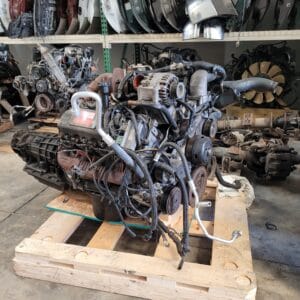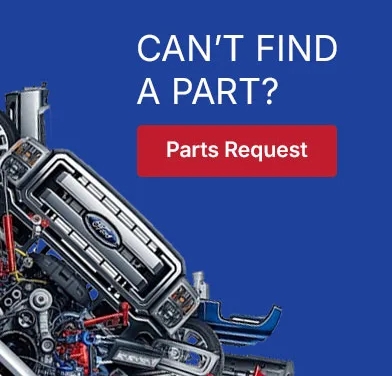No products in the cart.
The 6.0L Powerstroke Diesel Engine: A Complete Guide to Ford’s Most Controversial Workhorse
Introduction
 Few diesel engines spark as much debate as the 6.0L Powerstroke. Introduced in 2003 as the successor to the legendary 7.3L, the 6.0L was supposed to bring Ford’s Superduty trucks into compliance with stricter emissions regulations while improving horsepower, torque, and refinement. Instead, it became infamous for blown head gaskets, clogged EGR coolers, and complex repairs that frustrated both owners and dealerships.
Few diesel engines spark as much debate as the 6.0L Powerstroke. Introduced in 2003 as the successor to the legendary 7.3L, the 6.0L was supposed to bring Ford’s Superduty trucks into compliance with stricter emissions regulations while improving horsepower, torque, and refinement. Instead, it became infamous for blown head gaskets, clogged EGR coolers, and complex repairs that frustrated both owners and dealerships.
Yet, two decades later, the 6.0L has developed a second life. With proper upgrades, many of its weaknesses can be addressed, turning it into a reliable and powerful platform for work or recreation. This guide takes you through every facet of the 6.0L Powerstroke: its history, design, common issues, maintenance requirements, repair costs, bulletproofing upgrades, and how it compares to the 7.3L before it and the 6.4L that followed.
Development and History of the 6.0L PowerStroke
When the EPA rolled out new emissions requirements for 2004 model-year heavy-duty pickups, Navistar and Ford needed a cleaner-burning diesel engine. The old 7.3L, while legendary for durability, could not meet the updated NOx standards without major redesigns. The result was the 6.0L Powerstroke, internally called the VT365.
Launched in late 2002 for the 2003 model year, it offered:
- 325 horsepower (up from the 275–275 hp 7.3L)
- 560 lb-ft of torque
- Quieter operation
- More advanced electronics
- Exhaust Gas Recirculation (EGR) system
- A new Garrett Variable Geometry Turbocharger (VGT)
While the engine looked modern on paper, the reality was more complicated. Its advanced systems brought new failure points, and dealership technicians—many used to the relatively simple 7.3L—faced a steep learning curve. Reliability complaints quickly followed, and the 6.0L’s reputation was cemented.
Year-by-Year Changes
While all 6.0Ls share the same base architecture, Ford and Navistar made running revisions nearly every year to improve reliability. Understanding the differences is critical when shopping for one today.
- 2003 Models
First-year engines, with the highest rate of issues. Weak head gaskets, problematic EGR systems, and unreliable injectors were common. Generally considered the riskiest years. - 2004 Models
Split into “early” and “late” builds. Early engines suffered from many of the same problems as 2003. Midyear updates improved the turbo control, revised the EGR system, and strengthened some components. - 2005 Models
A major refresh year for the Superduty, including revised engine calibrations. Still had head stud and oil cooler issues, but generally more stable than earlier models. - 2006–2007 Models
Final iterations with the most factory improvements. Better injectors, revised turbo controls, and improved tuning made these the most desirable 6.0Ls from the factory.
Technical Overview
At its core, the 6.0L Powerstroke is a 32-valve, single-turbocharged V8 diesel with a displacement of 365 cubic inches. It used several advanced technologies for its time, many of which became double-edged swords.
High-Pressure Oil System and HEUI Injection
Like the 7.3L before it, the 6.0L used HEUI (Hydraulic Electronic Unit Injectors). This system relied on high-pressure engine oil (up to 4,000 PSI) to pressurize fuel injectors. The High-Pressure Oil Pump (HPOP) and oil rails fed the injectors, while the Fuel Injection Control Module (FICM) electronically commanded firing events.
Pros: Excellent atomization and emissions control.
Cons: Oil leaks, stiction in injectors, and complex diagnostics.
Turbocharging
The Garrett GT3782VA Variable Geometry Turbo was state-of-the-art. Its movable vanes adjusted exhaust flow, giving both strong low-end torque and high-end power. However, the vanes were prone to sticking from soot buildup, leading to “turbo lag” or overboost conditions.
EGR System
To meet emissions requirements, the 6.0L used an EGR cooler to recirculate exhaust gases. Unfortunately, the cooler often clogged with soot and coolant contamination, leading to ruptures. A failed EGR cooler could spike combustion temperatures, blowing head gaskets.
Cooling and Oil Systems
The stock oil cooler was a stacked-plate design prone to clogging with debris. Once it restricted flow, it starved the EGR cooler of coolant, creating a cascade of failures. This design remains one of the most critical weaknesses.
Common Problems
The 6.0L earned its reputation the hard way. Some of the most common and costly issues include:
- Head Gaskets and Head Bolts
The factory used torque-to-yield head bolts, which were not strong enough to withstand high cylinder pressures. This often led to blown gaskets, especially when towing or running tuners. The permanent fix is replacing them with ARP head studs. - EGR Cooler Failures
Clogged or ruptured EGR coolers caused overheating and gasket failures. Many owners delete the EGR system (illegal in some areas) or upgrade to bulletproof aftermarket coolers. - Oil Cooler Clogging
Once the oil cooler clogged, it created a domino effect—starving the EGR cooler, causing turbo issues, and starving injectors of lubrication. - FICM Failures
The Fuel Injection Control Module often failed due to poor soldering and heat stress. Symptoms include hard starts, rough idle, and misfires. - Turbo Sticking
The VGT vanes can seize from carbon buildup, requiring cleaning or replacement. - Stiction in Injectors
HEUI injectors rely on clean, high-quality oil. Contamination or breakdown of oil leads to “stiction,” where injectors fail to fire properly.
Maintenance and Service
The 6.0L is unforgiving if neglected. Strict maintenance is mandatory:
- Oil Changes: Every 5,000 miles with high-quality synthetic 15W-40.
- Coolant Flush: Every 30,000 miles; switching to an EC-1 rated ELC coolant prevents silicate buildup.
- Fuel Filters: Every 10,000–15,000 miles; dirty fuel quickly kills injectors.
- Turbo Cleaning: Periodically remove and clean VGT vanes to prevent sticking.
- Battery and Charging System: Weak batteries damage the FICM. Keep electrical systems healthy.
Bulletproofing the 6.0L
“Bulletproofing” refers to addressing the weak points with upgraded parts. A properly bulletproofed 6.0L can rival or exceed the reliability of many modern diesels.
Key upgrades include:
- ARP Head Studs
- Aftermarket Oil Cooler (or external cooler kit)
- Upgraded EGR Cooler (welded-tube or bypass)
- High-Performance FICM
- Quality Tuners (conservative programming to reduce cylinder pressures)
Bulletproofing costs vary widely. DIY builds may run $4,000–$6,000, while professional shops often charge $8,000–$12,000.
Ownership Experience
Unmodified 6.0Ls are risky, but bulletproofed examples can provide:
- Strong towing capacity (12,500+ lbs)
- Quick throttle response from the VGT turbo
- Smooth power delivery
- Surprisingly good fuel economy for its era (15–18 mpg highway)
The aftermarket is massive, and countless forums, Facebook groups, and YouTube channels support DIY owners.
Performance Potential
With tuning and upgrades, the 6.0L can make impressive power:
- Stock bottom ends hold 500–550 hp safely.
- Built engines can push beyond 800 hp with compound turbos.
- For towing, conservative tuning offers a sweet spot of 400–450 hp with reliability.
Comparison to Other PowerStrokes
- Vs. 7.3L Powerstroke
The 7.3L is more durable and simple but lacks power and refinement. The 6.0L is more powerful but requires upgrades to match durability. - Vs. 6.4L Powerstroke
The 6.4L fixed some issues but introduced new ones, such as poor fuel economy and expensive twin-turbo maintenance. - Vs. 6.7L Powerstroke
The modern 6.7L offers unmatched performance and reliability, but at a higher price point. The 6.0L can be a budget-friendly workhorse if upgraded.
Buying Advice
If you’re considering a used 6.0L Superduty today:
- Look for trucks with documented bulletproofing.
- Avoid early 2003–2004 engines unless already upgraded.
- Verify maintenance history—especially oil and coolant changes.
- Budget at least $5,000 for upgrades if not already completed.
Conclusion
The 6.0L Powerstroke is often misunderstood. Yes, it had design flaws that earned it a reputation for unreliability. But with knowledge, maintenance, and the right upgrades, the 6.0L can be transformed into a dependable, powerful, and enjoyable diesel engine. For those willing to invest the time and money, it offers a unique blend of performance and character that keeps it alive in the enthusiast community today. If you would prefer a different engine choice, such as the 6.7 Powerstroke or the 7.3 Powerstroke, visit those artyicles for further and in-depth information.
The Patriotic Philosopher of Possum County Billy Hill is what happens when a six-pack of root beer, a John Deere hat, and the U.S. Constitution have a baby in the back of a pickup truck. Hailing from the grand hills of somewhere-between-here-and-there, Billy proudly considers himself a “hillbilly” — but with a PhD in common sense and a minor in wrestling raccoons off his porch. With a mullet that flows like a bald eagle in slow motion and a wardrobe that screams “Walmart clearance aisle patriotism,” Billy doesn’t just love America — he is America. He celebrates the 4th of July so hard his neighbors file noise complaints with the bald eagle sanctuary three counties over. Billy’s life philosophy is simple: “If it ain’t broke, duct tape it anyway for extra freedom.” He doesn’t take life too seriously because, as he puts it, “Ain’t no point stressin’ when you got barbecue sauce and a recliner.” He believes everything in life can be solved with a grill, a beer, or a rousing debate about which state has the best gas station snacks. Billy once tried to start his own political party: The Red, White, and Brew Party: its platform consisting entirely of fireworks, lawn chairs, and banning low-fat anything. Whether he’s hunting invisible squirrels in flip-flops or giving unsolicited wisdom like “You can’t buy happiness, but you can buy bacon,” Billy Hill is the national treasure no one asked for, but America somehow deserves.


